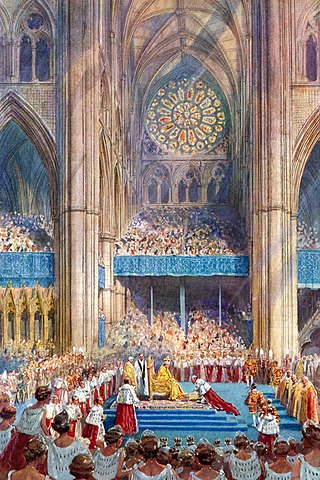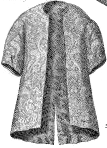
The Most Noble Order of the Garter is an order of chivalry founded by Edward III of England in 1348. The most senior order of knighthood in the British honours system, it is decoration outranked in precedence only by the Victoria Cross and the George Cross. The Order of the Garter is dedicated to the image and arms of Saint George, England's patron saint.

Crown jewels are the objects of metalwork and jewellery in the regalia of a current or former monarchy. They are often used for the coronation of a monarch and a few other ceremonial occasions. A monarch may often be shown wearing them in portraits, as they symbolize the power and continuity of the monarchy. Additions to them may be made, but, since medieval times, the existing items have been typically passed down unchanged, symbolizing the continuity of a monarchy.

A coronation is the act of placement or bestowal of a crown upon a monarch's head. The term also generally refers not only to the physical crowning but to the ceremony wherein the act of crowning occurs, along with the presentation of other items of regalia, marking the formal investiture of a monarch with regal power. Aside from the crowning, a coronation ceremony may comprise many other rituals such as the taking of special vows by the monarch, the investing and presentation of regalia to the monarch, and acts of homage by the new ruler's subjects and the performance of other ritual deeds of special significance to the particular nation. In certain Christian denominations, such as Lutheranism and Anglicanism, coronation is a rite. As such, Western-style coronations have often included anointing the monarch with holy oil, or chrism as it is often called; the anointing ritual's religious significance follows examples found in the Bible. The monarch's consort may also be crowned, either simultaneously with the monarch or as a separate event.

The Crown Jewels of the United Kingdom, originally the Crown Jewels of England, are a collection of royal ceremonial objects kept in the Jewel House at the Tower of London, which include the coronation regalia and vestments worn by British monarchs.

St Edward's Crown is the centrepiece of the Crown Jewels of the United Kingdom. Named after Saint Edward the Confessor, versions of it have traditionally been used to crown English and British monarchs at their coronations since the 13th century.

The Imperial State Crown is one of the Crown Jewels of the United Kingdom and symbolises the sovereignty of the British monarch. It has existed in various forms since the 15th century. The 1937 version is worn by a new monarch for the first time in the royal procession following their coronation and subsequently used at State Openings of Parliament. The crown is adorned with 3,170 precious stones, including the Cullinan II diamond, St Edward's Sapphire, the Stuart Sapphire, and the Black Prince's Ruby.

The coronation of the monarch of the United Kingdom is an initiation ceremony in which they are formally invested with regalia and crowned at Westminster Abbey. It corresponds to the coronations that formerly took place in other European monarchies, which have all abandoned coronations in favour of inauguration or enthronement ceremonies. A coronation is a symbolic formality and does not signify the official beginning of the monarch's reign; de jure and de facto their reign commences from the moment of the preceding monarch's death or abdication, maintaining legal continuity of the monarchy.

The Coronation Chair, also known as St Edward's Chair or King Edward's Chair, is an ancient wooden chair on which British monarchs sit when they are invested with regalia and crowned at their coronations. It was commissioned in 1296 by King Edward I to contain the Stone of Scone, which he had captured from the Scots. The chair was named after Edward the Confessor and for centuries it was kept in his shrine at Westminster Abbey.

The coronation of Elizabeth II as queen of the United Kingdom and the other Commonwealth realms took place on 2 June 1953 at Westminster Abbey in London. She acceded to the throne at the age of 25 upon the death of her father, George VI, on 6 February 1952, being proclaimed queen by her privy and executive councils shortly afterwards. The coronation was held more than one year later because of the tradition of allowing an appropriate length of time to pass after a monarch dies. It also gave the planning committees adequate time to make preparations for the ceremony. During the service, Elizabeth took an oath, was anointed with holy oil, was invested with robes and regalia, and was crowned Queen of the United Kingdom, Canada, Australia, New Zealand, South Africa, Pakistan, and Ceylon.

Coronations were previously held in the monarchies of Europe. The United Kingdom is the only monarchy in Europe that still practises coronation. Other European monarchies have either replaced coronations with simpler ceremonies to mark an accession or have never practised coronations. Most monarchies today only require a simple oath to be taken in the presence of the country's legislature.

Coronations in Oceania are, or were, held in the following countries:

The coronation of George VI and his wife, Elizabeth, as king and queen of the United Kingdom and the Dominions of the British Commonwealth, Emperor and Empress consort of India took place at Westminster Abbey, London, on Wednesday 12 May 1937. George VI ascended the throne upon the abdication of his brother, Edward VIII, on 11 December 1936, three days before his 41st birthday. Edward's coronation had been planned for 12 May and it was decided to continue with his brother and sister-in-law's coronation on the same date.

Several Swedish coronation robes from the 16th to the 19th century are preserved at The Royal Armoury in Stockholm, Sweden. The youngest one, Oscar II's coronation robe from 1873, is in the Treasury at Stockholm Palace.

Peerage robes are worn in the United Kingdom by peers and are of two varieties for two occasions: Parliament robes, worn on ceremonial occasions in the House of Lords, and Coronation robes, worn at coronations of monarchs.

A royal mantle, or more simply a Mantle, is a garment normally worn by emperors, kings or queens as a symbol of authority. When worn at a coronation, such mantles may be referred to as coronation mantles. Many princes also wear such a mantle. Sometimes the mantles are worn only once, but in other instances they may be worn or used on other occasions, such as during the opening of a session of the nation's legislature. Mantles also feature prominently in state portraiture and artwork featuring monarchs and princes.

The coronation of Charles III and his wife, Camilla, as king and queen of the United Kingdom and the other Commonwealth realms, took place on Saturday, 6 May 2023 at Westminster Abbey. Charles acceded to the throne on 8 September 2022 upon the death of his mother, Elizabeth II. It was the first coronation held since Elizabeth II’s coronation in 1953 nearly 70 years prior.

The Robe of State is a robe worn by the British monarch on state occasions. A monarch typically has a robe made for their coronation and reuses it when attending the State Opening of Parliament at the start of each legislative session. Traditionally the robes have an ermine cape with a long train made of crimson coloured velvet, trimmed in gold lace and lined with ermine.

A Supertunica is a robe worn by a British monarch at their coronation. It is donned shortly after the Anointing ceremony for the vesting of the Spurs, Sword of Offering and the Armills. Afterwards the Stole Royal and Robe Royal are worn on top of the Supertunica for the crowning of the monarch. The Supertunica, Stole and Robe are replaced with the Imperial Robe for the final procession from Westminster Abbey.

The Stole Royal is an item of regalia used during the coronation of a British monarch, similar to the stoles worn as vestments by clergymen. It is donned after the anointing of the monarch and is worn throughout the crowning, receiving of homage and conclusion of the communion. The Stole Royal is removed, with other garments, before the procession from Westminster Abbey for which the Imperial Robe is worn.

The Robe Royal is a robe worn by the British monarch when they are crowned at their coronation. It is donned just before the monarch is invested with the Orb, Ring and Sceptres. It is worn during the crowning and paying of homage. The Robe Royal used is one originally created for the 1821 coronation of George IV.


















